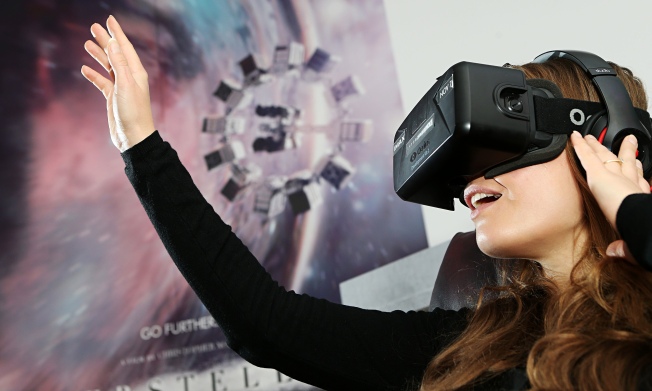My avatar materialized in front of my locker on the second floor of my high school – the exact spot where I’d been standing when I’d logged out the night before. I glanced up and down the hallway. My virtual surroundings looked almost (but not quite) real. Everything inside the OASIS was beautifully rendered in three dimensions. Ready Player One – Ernest Cline (2011)
Science fiction authors have been writing about Virtual Reality (VR) and Augmented Reality for decades now. And at least as long we are trying to make it come true. In the nineties with equipment costing tens of thousands of euro’s and weighing several kilo’s. But now we are seeing more and more VR and AR headsets that weigh as much as a can of soda, only costing a few hundred euro’s. VR and AR are on the brink of becoming reality, so what does that mean for you?
Virtual reality
First, let’s briefly explain what VR is. It simulates a world which the user perceives as real. Because this technology presents the virtual world convincingly to one or more of the senses, mainly vision. Nowadays this is already possible with a small headset, plugged into a PC, or by using a Smartphone. Such a VR-headset shuts off your eyes and ears from the real word, and presents them a virtual world, which makes your brain think you are actually present in that virtual world. This make VR a very personal experience, something you cannot easily combine with other activities.
Augmented reality
AR is a technology that adds information or images to the reality of the user. Just like VR, this is now possible with fairly cheap and light equipment. Although for a really big experience more advanced equipment is needed. Because AR combines the reality of the user with computer generated information, the experience is more open than VR. You can interact with your environment, while your reality is enhanced by this technology.
The big difference
So the difference for users between both technologies is how deep you are immerged. VR is comparable to visiting a movie theatre or dreaming, you are living the experience and shut off from the outside world. AR adds something to your world. It combines the virtual with the real. More like subtitles on the television, or the world map in the GTA games. This difference means that both technologies have really different use cases.
Virtual Reality now!
At this stage the development of VR is further advanced than AR. Already there are multiple different products launched, or going to launched in the coming months. Like the Oculus Rift, the Samsung Gear VR and the HTC Vive. 2015 and 2016 are going to be big VR years.
Because this technology is so immersive, it is especially useful for three different areas. The first is entertainment, like games or video. There is already some content in this area, but there is still a lot of experimentation. Because it is not possible to simply port 2D to 3D. Because the wearer of the VR-helmet is not just viewing it on a screen, but is in the middle of it, and has the possibility to look all around her or him. So the content has to be specifically made or adjusted for the VR experience. Like filming a movie, only in 360 degrees. WeMakeVR from Amsterdam designed their own camera to make such 360 degree movies. Besides shooting the video, or making the game, there are other problems to be dealt with. How do you align the movement in a game or video, with the perception of the VR user? Because the movement in a game can be very intense, while the user is sitting still on a chair or a couch. In the game Elite: Dangerous you play the pilot of a space ship. And because the pilot stays inside his cockpit, sitting on his spaceship chair, the movement is aligned with the movement of the user, sitting in a normal at home chair. If the movement is not aligned, the player would get really nauseous, really fast.
The second area VR has a lot of opportunities in, is in showing environments that are not easily accessible, or are not yet realised. For instance, an architect can let customers walk through a building that has not yet been build, to show them how it will look. Another example is using VR for people who are less mobile to virtually walk in the Swiss Alps. Experiences like this are being built by different companies, like the Beeldenfabriek from Rotterdam.
The last area VR can bring a lot is simulation. VR can be uses to train people for situations that are hard to practice in real life. Like how to act in an emergency in a nuclear plant. These kind of simulations are already being used, for training soldiers. But also for helping those same soldiers to cope with traumas.
And keep a close eye on Augmented Reality
There are already different AR applications in the market, like the Apps Layar builds. But it will take a few years before AR will breakthrough with the masses. Because for a big and convincing experience, more advanced technology is required. If your AR headset, or glasses want to augment your view realistically, they have to combine the information they provide with the real world. Both have to be stitched together. To be able to do that, he headset has to understand what it is seeing, and it takes a lot of complex technology to do that. Simply put, if you are wearing AR glasses, and you want to know more about the person next to you, the glasses have to do a lot of things. First they should be able to recognise objects or living creatures. Second, the glass should be able to identify the person. Third, it has to be able to present the information about that person in a correct way in your view. And last, it has to do that constantly, updating every millisecond, because you and the world around you are constantly changing.
But within a few years there will be cheap and user friendly gear that can do just that. And when that time comes AR will provide more possibilities than VR. Like mentioned earlier, VR immerses you into an experience, so you can only use it at certain moments, for certain use cases. AR on the other hand enriches your world, and can be uses all through the day, for different scenario’s. AR is potentially useful for every job that requires you to use your hands. Because it can add instructions, directions, communication, etcetera to your field of view, without you having to look for the information on a smartphone or a PC. A soldier could use it during combat to get updates on targets, a taxi driver could use it to see directions and a doctor to view information about a condition, while helping a patient. But also if you are not a professional AR can make your life easier, imagine yourself walking through busy city street with your two small kids with you. It would be a lot easier to find your way and contact your wife or husband that you will be home a little late if you would have a small information screen in your field of view, that you could use to navigate and communicate with the people at home.
If you are saying ‘Google glass already promised that, but it didn’t work!” you are right. The first version of Google Glass was a basic form of augmented reality, but it wasn’t advanced, small and cheap enough to deliver. In the coming years technology will reach the market that will fulfil that promise.
Besides the practical uses mentioned above, AR is also usable for entertainment. An AR headset can be uses to play videogames that take place in the real world, or to play real worl games, enriched with video images. So on the long term AR offers a lot more possibilities than VR, and maybe it will even turn into something we use constantly, like our smartphones now.
What does this mean?
So in 2015 and 2016 we are going to see a lot of people using VR headsets to enjoy games, video and other applications. We are in the middle of this technology becoming mainstream, and that is an exciting time. A lot of people are pioneering this technology and finding all kinds of uses for it. For organisations and professionals in entertainment, education or that use visualisation or simulation, this is the time to look into VR and find out if and how it can help you.
The great breakthrough for AR will be in the coming years, probably when products like the Microsoft Hololens, Google Glass 2 and the mysterious Magic Leap will fully mature. The possibilities of AR at this very moment are limited, but it is definitely a technology to keep a close eye on for the near future because of its immense potential. And it is also very possible that both technologies will converge in the future, requiring only a single device that can give you both experiences.
@nielsbergervoet
(This blog post is a translated and updated version of the Dutch version posted here.)



